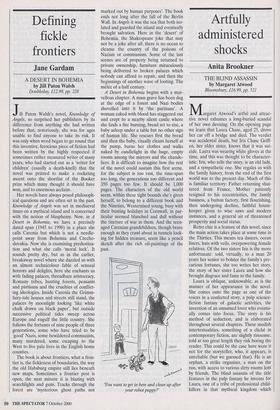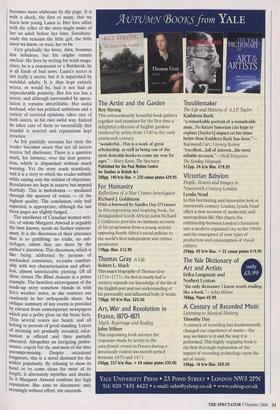Artfully administered shocks
Anita Brookner
THE BLIND ASSASSIN by Margaret Atwood Bloomsbury, £16.99, pp. 521 Margaret Atwood's artful and attrac- tive novel exhumes a long-buried scandal of her own devising. On the opening page we learn that Laura Chase, aged 25, drove her car off a bridge and died. The verdict was accidental death, but Iris Chase Griff- en, her elder sister, knows that it was sui- cide. Laura was wearing white gloves at the time, and this was thought to be character- istic. Iris, who tells the story, is an old lady, and a sympathetic one. She regales us with the family history, from the end of the first world war to the present day. Much of this is familiar territory: Father returning shat- tered from France, Mother patiently resigned to his eccentricities, the family business, a button factory, first flourishing, then undergoing decline, faithful house- keeper given to wise saws and modern instances, and a general air of threatened prosperity and social status.
Retro chic is a feature of this novel, since the main action takes place at some time in the Thirties. This means tea dances, ocean liners, hats with veils, overpowering female relatives. Of the two sisters Iris is the more unfortunate: sold, virtually, to a man 20 years her senior to bolster the family's pre- carious fortunes, she too writes her story, the story of her sister Laura and how she brought disgrace and fame to the family.
Laura is oblique, unknowable, as is the manner of her appearance in the novel. She comes onto the page as one of the voices in a confected story, a pulp science- fiction fantasy of galactic activities, the invention of an unnamed lover who eventu- ally comes into focus. The story is his method of seduction, and is elaborated throughout several chapters. These modish intertextualities, something of a cliche in contemporary fiction, are slightly tiresome; told at too great length they risk boring the reader. This could be the case here were it not for the storyteller, who, it appears, is unreliable (but we guessed that). He is an orphan, a strike organiser, a man on the run, with access to various dirty rooms lent by friends. The blind assassin of the title features in the pulp fantasy he invents for Laura, one of a tribe of professional child- killers in that mythical kingdom which becomes more elaborate by the page. It is with a shock, the first of many, that we learn how young Laura is. Her love affair with the teller of the story might make of her an adult before her time. Simultane- ously she remains the little girl, the little sister we know, or trust, her to be.
Very gradually the lover, Alex, becomes less nebulous, but his origins remain unclear. He lives by writing for trash maga- zines; he is a communist or a Bolshevik; he is all kinds of bad news. Laura's secret is not really a secret, but it is supervised by watchful adults. It is thus kept entirely secret, or would be, had it not had an unpredictable posterity. But Iris too has a secret, and although surrounded by specu- lation it remains unverifiable. Her awful husband, who has political ambitions and a variety of received opinions, takes care of both sisters, in his own awful way. Indeed he takes care of them so successfully that scandal is averted and reputations kept inviolate.
As Iris painfully recounts her story the reader becomes aware that not all secrets receive full disclosure. There is a question mark, for instance, over the next genera- tion, which is dispatched without much warning. Yet the story reads seamlessly, and it is a story to which the reader submits while raising only the mildest of objections. Revelations are kept in reserve but impend fearfully. This is melodrama — mediated through the quietest of voices — of the highest quality. The conclusion, only half expected, is appropriate, although the last three pages are slightly fudged.
The excellence of Canadian women writ- ers, of whom Margaret Atwood is arguably the best known, needs no further endorse- ment. It is the directness of their utterance that is so gratifying: no tricks, no sub- terfuges, unless they are there by the author's intention. This directness, which is like being addressed by persons of unclouded conscience, co-exists comfort- ably with wry characterisation and effort- less, almost unnoticeable plotting. Of all these virtues The Blind Assassin is a prime example. The heartless extravagance of the made-up story somehow blends in with Iris's weather notes, as she ventures out cautiously in her orthopaedic shoes. An oblique summary of key events is provided by extracts from contemporary newspapers which put a polite gloss on the brute facts. Thus several voices are heard, and all belong to persons of good standing. Layers of meaning are gradually revealed; infor- mation is offered and then partially obscured. Altogether an intriguing perfor- mance, cogent but sly, and most of the time uncompromising. Despite occasional longueurs, this is a novel destined for the widest popularity. By refusing to show its hand or to come clean for most of its length, it alternately mystifies and shocks. In it Margaret Atwood confirms her high reputation. She aims to disconcert, and, seemingly without effort, she succeeds.



















































































 Previous page
Previous page